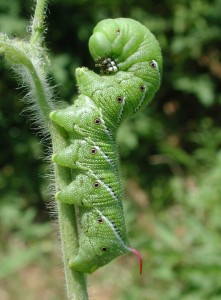Insects: Three names bad, two names good?

Emerald Ash Borer, a three name pest right in your face. Photo: Macroscopic Solutions, Creative Commons, some rights reserved
Lawn, landscape, and garden season will be here any day. Or so we hope. As a card-carrying pessimist, the arrival of spring naturally brings to mind the critters that will soon come out of the woodwork (literally in some cases) to complicate those activities.
Ruminating about insect pests, particularly invasive species, it occurred to me there is a painless way to evaluate them for damage potential. I’m calling it the “Insect Pest Three-Name Litmus Test.” Here’s how it works: When you find an unknown insect in your garden, lawn, tree or shrub, key it out. What’s it called? Specifically, how many names does it have?
It must be one of those inscrutable laws of nature, like how an object (such as me) at rest likes to stay at rest. Stuff you drop tends to fall down, not so often up. Energy can change form but can’t be created or destroyed. Evil, more often than not, uses three names.
Think about notorious villains: John Wilkes Booth, Lee Harvey Oswald, John Wayne Gacy, Attila the Hun, Cruella de Vil, Vinnie The Lawyer, Big Bad Wolf. Three names. Lots of people have three names, but they don’t get in your face with all of them at once. I see my middle name as a kind of spare, in case my first name wears out or gets copyrighted or something. If “Paul” becomes the intellectual property of some corporation, I’ll dust off my middle name, but until then I won’t rub everyone’s nose in it.
In contrast, look at our heroes — Jesus Christ, Desmond Tutu, Mother Teresa, Neil Armstrong, Ralph Nader, Gandhi, Buddha, Martin Luther King Junior. I’m just establishing a pattern here.
The natural world bears this out as well. A great white shark will eat you, but a basking shark won’t. Black widow spiders are deadly. Wolf spiders, while hairy and uncomfortably large, are completely benign. European red elderberry, poisonous. Black elderberry, safe to eat. Eastern coral snake, venomous. Milk snake, not. The relationship is undeniable.
Now consider the bad actors of the insect realm — emerald ash borer, which will eventually destroy New York State’s 900 million or so ash trees. Spotted-wing drosophila, which discovered in northern New York in 2012, decimates fall raspberries and late-season blueberries. God forbid we ever get the Asian longhorn beetle, which has the potential to destroy almost every hardwood species we have.
Brown marmorated stinkbugs will be in New York’s North Country within a few years to munch on fruit of all kinds. Greenery of all kinds, too, come to think of it. Colorado potato beetle, hemlock wooly adelgid, eastern tent caterpillar, striped cucumber beetle, sirex wood wasp, viburnum leaf beetle, western bean cutworm — the three-name list of evildoers is endless.
But check out the names of beneficial insects — Praying mantis. Ichneumon wasp. Syrphid fly. Lacewing. Honeybee. Ladybug. Dragonfly. Scientific proof — need I say more?
Not only does the Insect Pest Three-Name Litmus Test rhyme, it is revolutionary in its simplicity. Three names; probably bad. One, two, four names; probably good, or benign at the very least.
I don’t want to hear a dang word from anyone about tomato hornworms, squash bugs or flea beetles, because I plan to lobby the appropriate agency to get middle names for those few spoilers. I expect a Nobel in Science for this, or at least a spot in the Science Hall of Fame, or whatever they have.
Now I’m thinking, maybe I should switch to decaf.
Paul Hetzler is a horticulture and natural resources educator with Cornell Cooperative Extension of St. Lawrence County.
Tags: environment, insect pests, invasive species, zoology








